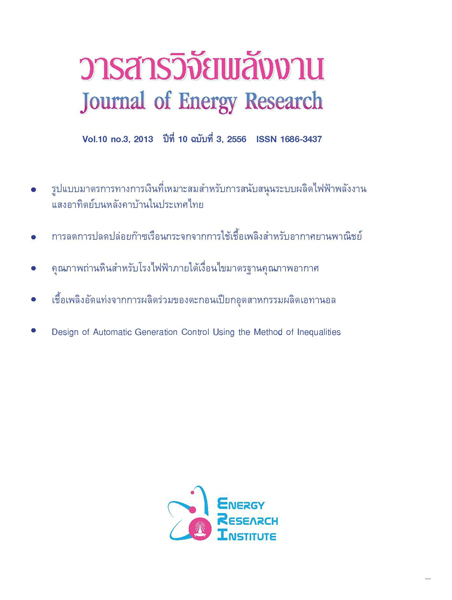คุณภาพถ่านหินสำหรับโรงไฟฟ้าภายใต้เงื่อนไขมาตรฐานคุณภาพอากาศ
Main Article Content
Abstract
คุณภาพถ่านหินที่เหมาะสมสำหรับโรงไฟฟ้าถ่านหินภายใต้เงื่อนไขคุณภาพอากาศในบรรยากาศขึ้นอยู่กับหลายปัจจัย เช่น ประสิทธิภาพโรงไฟฟ้า ค่าความร้อน ปริมาณกำมะถัน(Sulfur content) ปริมาณเถ้า(Ash Content) และ ประสิทธิภาพของระบบกำจัดมลพิษทางอากาศ เป็นต้น จากผลการศึกษาพบว่า กรณีโรงไฟฟ้าขนาดน้อยกว่า 50 เมกกะวัตต์ ประสิทธิภาพโรงไฟฟ้าร้อยละ 40 ประสิทธิภาพระบบกำจัดก๊าซซัลเฟอร์ไดออกไซด์และฝุ่นละอองร้อยละ 96 และ 99 ตามลำดับ ดังนั้น กรณีถ่านหินมีค่าความร้อน 3,200 กิโลแคลอรีต่อกิโลกรัม พบว่าปริมาณกำมะถันและเถ้าของถ่านหินจะต้องไม่สูงกว่าร้อยละ 0.73 และ 2.61 ตามลำดับ กรณีถ่านหินมีค่าความร้อน 5,000 กิโลแคลอรีต่อกิโลกรัม พบว่าปริมาณกำมะถันและเถ้าของถ่านหินจะต้องไม่สูงกว่าร้อยละ 1.13 และ 4.07 ตามลำดับ และกรณีถ่านหินมีค่าความร้อน 6,000 กิโลแคลอรีต่อกิโลกรัม พบว่าปริมาณกำมะถันและเถ้าของถ่านหินจะต้องไม่สูงกว่าร้อยละ 1.36 และ 4.89 ตามลำดับ ส่วนกรณีโรงไฟฟ้าขนาดมากกว่า 50 เมกกะวัตต์ขึ้นไป ประสิทธิภาพโรงไฟฟ้าร้อยละ 40 ประสิทธิภาพระบบกำจัดก๊าซซัลเฟอร์ไดออกไซด์และฝุ่นละอองร้อยละ 96 และ 99 ตามลำดับ โดยที่กรณีถ่านหินมีค่าความร้อน 3,200 กิโลแคลอรีต่อกิโลกรัม พบว่าปริมาณกำมะถันและเถ้าของถ่านหินจะต้องไม่สูงกว่าร้อยละ 0.36 และ 2.61 ตามลำดับ กรณีถ่านหินมีค่าความร้อน 5,000 กิโลแคลอรีต่อกิโลกรัม พบว่าปริมาณกำมะถันและเถ้าของถ่านหินจะต้องไม่สูงกว่าร้อยละ 0.57 และ 4.07 ตามลำดับ และกรณีถ่านหินมีค่าความร้อน 6,000 กิโลแคลอรีต่อกิโลกรัม พบว่าปริมาณกำมะถันและเถ้าของถ่านหินจะต้องไม่สูงกว่าร้อยละ 0.68 และ 4.89 ตามลำดับ นอกจากนี้ การสำรวจศักยภาพการของโรงไฟฟ้าถ่านหินในพื้นที่ศึกษา 29 จังหวัด พบว่ามี 8 จังหวัดที่มีศักยภาพในการสร้างโรงไฟฟ้าถ่านหินเพิ่มได้
COAL QUALITY FOR POWER PLANT UNDER AIR QUALITY STANDARDS CONDITIONS
Seksan Sangdow1 and Thitisak Boonpramote2
1Pollution Control Department & Energy Research Institute, Chulalongkorn University
2Departments of Mining and Petroleum Engineering, Faculty of Engineering, Chulalongkorn University
The coal quality to be used as fuel in power plant under air quality standards conditions was found to depend on various factors like thermal efficiency of power plant, heating value of coal, sulfur content in coal, ash content of coal, and efficiency of air pollution control units (APC). When focusing on these results, it would be found that If size of power plant was less than 50 megawatts, thermal efficiency was 40 percent, efficiency of APC for Sulfur Dioxide and Particulate Matter were 96 and 99 percent, respectively, In case of heating value of coal was 3,200 kcal/Kg, sulfur and ash content of coal should not be more than 0.73 and 2.61 percent, respectively, In case of heating value of coal was 5,000 Kcal/Kg, sulfur and ash content of coal should not be more than 1.13 and 4.07 percent, respectively, and In case of heating value of coal was 6,000 Kcal/Kg, sulfur and ash content of coal should not be more than 1.36 and 4.89 percent, respectively, If size of power plant was more than 50 megawatts, thermal efficiency was 40 percent, and efficiency of APC for Sulfur Dioxide and Particulate Matter were 96 and 99 percent, respectively, In case of heating value of coal was 3,200 kcal/Kg, sulfur and ash content of coal should not be more than 0.36 and 2.61 percent, respectively, In case of heating value of coal was 5,000 Kcal/Kg, sulfur and ash content of coal should be less than 0.57 and 4.07 percent, respectively, and In case of heating value of coal was 6,000 Kcal/Kg, sulfur and ash content of coal should be less than 0.68 and 4.89 percent, respectively, In term of potential capacity of coal fire power plant in the study area (29 provinces), there were 8 provinces which would be able to carry these capacities within air quality conditions.

